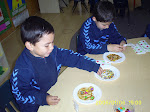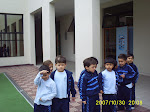martes, 3 de junio de 2008
martes, 12 de febrero de 2008
The benefits of cooperative and collaborative learning
The blog shows the Collaborative learning like a method of teaching and learning in which students team together to explore a significant question or create a meaningful Project. In small groups, students can share strengths and also develop their weaker skills. Also the beneficials of the work in small groups and the recommendations from advocates of cooperative learning.
https://www.religionethics.com/edonline/concept2class/coopcollab/index.html
https://www.religionethics.com/edonline/concept2class/coopcollab/index.html
Constructing knowledge in the classroom
This page remember us that the early years provide the basis for language, physical dexterity, social understanding, and emotional development that the children will use for the rest of their lifes. Also the importance of the knowledge, beliefs, and skills an individual brings to the experience of learning. It show us the rol of the constructivist teacher.
Our students represent a rich array of different backgrounds and ways of thinking. If the classroom can provide a neutral zone where students exchange their personal views and test them against the ideas of others.
http://www.sedl.org/scimath/compass/v01n03/1.html
Our students represent a rich array of different backgrounds and ways of thinking. If the classroom can provide a neutral zone where students exchange their personal views and test them against the ideas of others.
http://www.sedl.org/scimath/compass/v01n03/1.html
Systematic instruction and project work
This web brings the aspects of the currículo based in Project work:
1. Systematic instruction for the acquisition of skills.
2. Project work for the application of skills.
And raise the three phases of a Project.
1. Starting point, there’s the opening event which stimulates interest for the class.
2. In preparation for field work: Field trip. The class can go to a site which affords opportunities; Field work follow-up. discuss, recreate accounts of what happened; Visiting experts can be invited to the class.
3. Concluding the Project: final event.This provides an opportunity to review and evaluate.
www.eduscapes.com
1. Systematic instruction for the acquisition of skills.
2. Project work for the application of skills.
And raise the three phases of a Project.
1. Starting point, there’s the opening event which stimulates interest for the class.
2. In preparation for field work: Field trip. The class can go to a site which affords opportunities; Field work follow-up. discuss, recreate accounts of what happened; Visiting experts can be invited to the class.
3. Concluding the Project: final event.This provides an opportunity to review and evaluate.
www.eduscapes.com
lunes, 11 de febrero de 2008
PBL handbook
This is the BIE (Buck Institute of Education) home page. Here we can find The BIE Project Based Learning Handbook that is a guide of a new vision of the PBL method. This book explain us how to get the best out of our students.
Using the Project planning forms, that are the tools for implementing a project, we can have the best results of our PBL. This whole process is explain in this handbook, that is a very useful guide for every teacher that is in the hunt of new learning experiences that take their students to the success.
http://www.bie.org/index.php/site/PBL/pbl_handbook/
Using the Project planning forms, that are the tools for implementing a project, we can have the best results of our PBL. This whole process is explain in this handbook, that is a very useful guide for every teacher that is in the hunt of new learning experiences that take their students to the success.
http://www.bie.org/index.php/site/PBL/pbl_handbook/
Researches in PBL
We can see in this page the results of an interesting researches made in USA and Britain that analyze the different responses from the students groups that were taught in a traditional way against those from students that used the PBL method.
Categories as basic math, word problems, planning capabilities, students content, attention and feedback, were some of the best performed areas of the students, in contrast of those who hadn’t the experience of been taught with PBL.
http://www.edutopia.org/project-based-learning-research
Categories as basic math, word problems, planning capabilities, students content, attention and feedback, were some of the best performed areas of the students, in contrast of those who hadn’t the experience of been taught with PBL.
http://www.edutopia.org/project-based-learning-research
Important links (sources of PBL)
This blog explores the different uses of PBL in the school. By really useful links this page gives us lots of examples and information about how to use this method in our context, depending on the age of our students, their interest and the subjects that we want to work. It presents an interesting video that shows vividly how the students experiment a PBL process by acting directly in the concrete situation.
It talks about the importance of using this method in order to develop in our students skills such as self-determination, problem solving, understanding different subjects and academic matters.
It talks about the importance of using this method in order to develop in our students skills such as self-determination, problem solving, understanding different subjects and academic matters.
Suscribirse a:
Comentarios (Atom)







